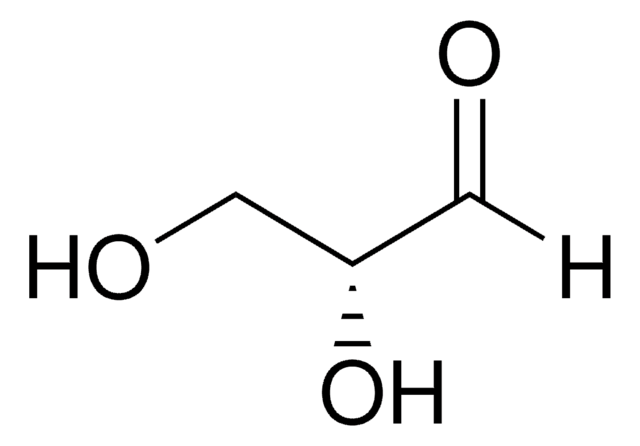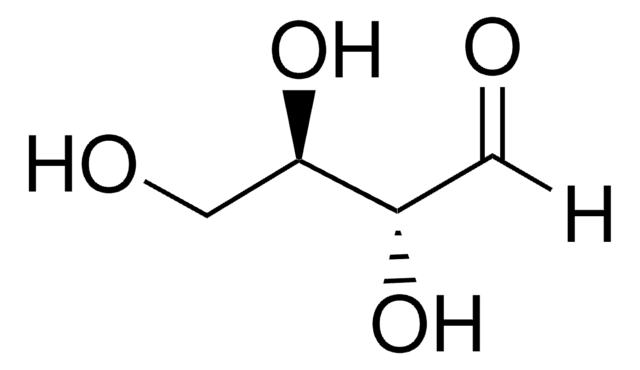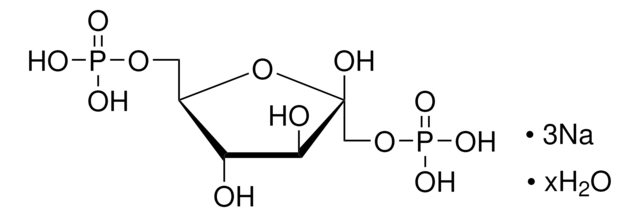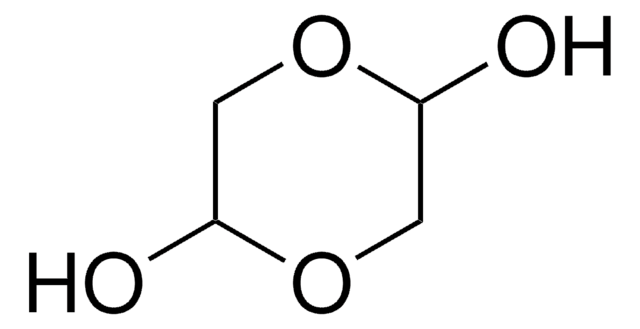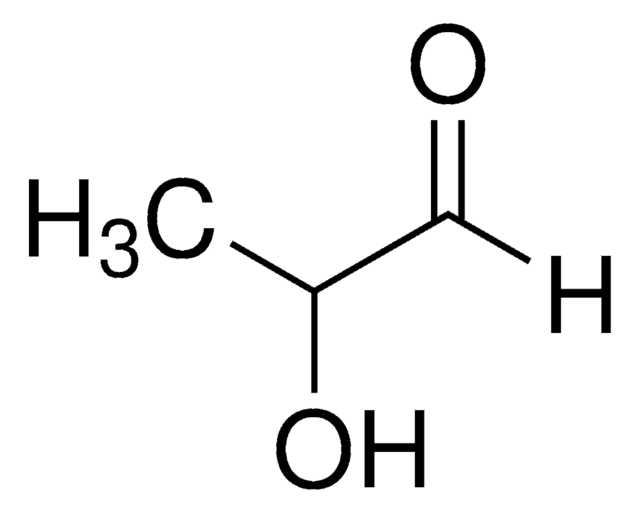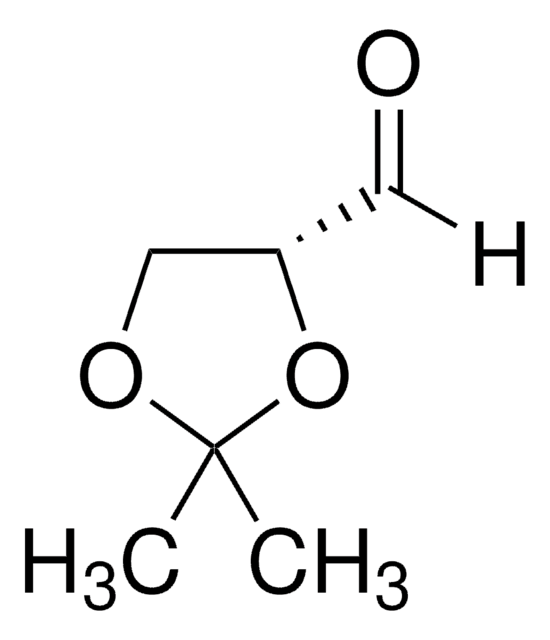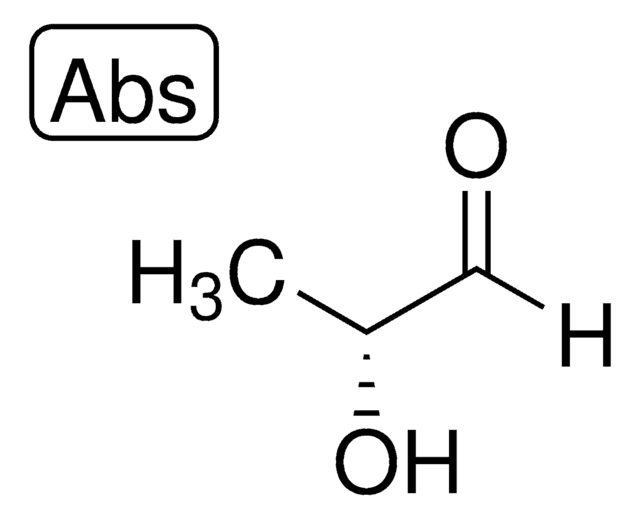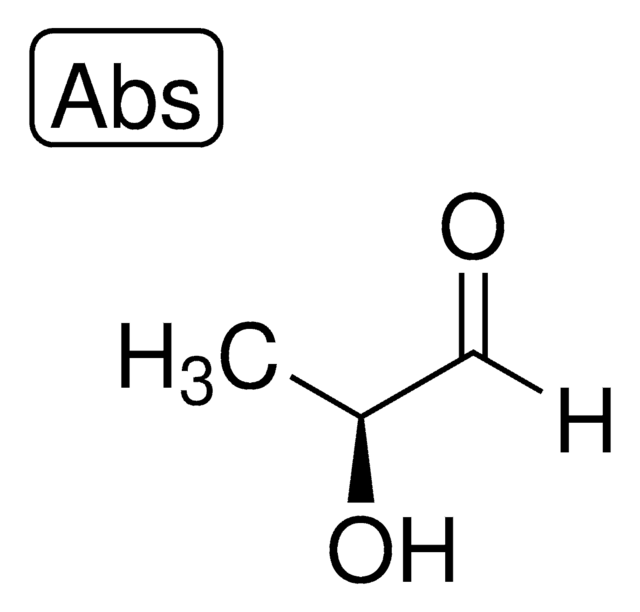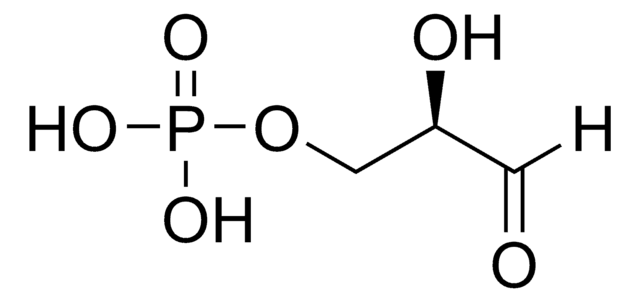73572
L-(−)-Glyceraldehyde
≥90% (HPLC)
Sinónimos:
(2S)-2,3-Dihydroxypropanal
Iniciar sesiónpara Ver la Fijación de precios por contrato y de la organización
About This Item
Fórmula empírica (notación de Hill):
C3H6O3
Número de CAS:
Peso molecular:
90.08
Beilstein/REAXYS Number:
1720475
EC Number:
MDL number:
UNSPSC Code:
12352204
PubChem Substance ID:
NACRES:
NA.32
Productos recomendados
Quality Level
assay
≥90% (HPLC)
optical activity
[α]/D -11.0±3.0°, c = 2 in H2O (after 24 h)
solubility
water: soluble 30 g/L at 18 °C
storage temp.
2-8°C
SMILES string
OC[C@H](O)C=O
InChI
1S/C3H6O3/c4-1-3(6)2-5/h1,3,5-6H,2H2/t3-/m1/s1
InChI key
MNQZXJOMYWMBOU-GSVOUGTGSA-N
¿Está buscando productos similares? Visita Guía de comparación de productos
Categorías relacionadas
Application
- L-Glyceraldehyde Inhibits Neuroblastoma Cell Growth via a Multi-Modal Mechanism on Metabolism and Signaling.: This research highlights the inhibitory effects of L-Glyceraldehyde on neuroblastoma cell growth, revealing its impact through multiple pathways in metabolism and cell signaling (Forbes M et al., 2024).
Biochem/physiol Actions
L-(-)-Glyceraldehyde is an important intermediate in carbohydrate metabolism.
Packaging
Bottomless glass bottle. Contents are inside inserted fused cone.
Other Notes
To gain a comprehensive understanding of our extensive range of Monosaccharides for your research, we encourage you to visit our Carbohydrates Category page.
Storage Class
10 - Combustible liquids
wgk_germany
WGK 3
flash_point_f
233.6 °F - closed cup
flash_point_c
112 °C - closed cup
Elija entre una de las versiones más recientes:
¿Ya tiene este producto?
Encuentre la documentación para los productos que ha comprado recientemente en la Biblioteca de documentos.
Los clientes también vieron
David A Korasick et al.
Journal of molecular biology, 431(3), 576-592 (2018-12-24)
Heterokonts, Alveolata protists, green algae from Charophyta and Chlorophyta divisions, and all Embryophyta plants possess an aldehyde dehydrogenase (ALDH) gene named ALDH12. Here, we provide a biochemical characterization of two ALDH12 family members from the lower plant Physcomitrella patens and
Nina Richter et al.
Biotechnology and bioengineering, 106(4), 541-552 (2010-03-04)
A whole-cell catalyst using Escherichia coli BL21(DE3) as a host, co-expressing glycerol dehydrogenase (GlyDH) from Gluconobacter oxydans and glucose dehydrogenase (GDH) from Bacillus subtilis for cofactor regeneration, has been successfully constructed and used for the reduction of aliphatic aldehydes, such
Cancer biomarker AKR1B10 and carbonyl metabolism.
Balendiran, G. K., et al.
Chemistry & Biology, 178, 134-137 (2009)
Nina Richter et al.
Chembiochem : a European journal of chemical biology, 10(11), 1888-1896 (2009-07-07)
The acetic acid bacterium Gluconobacter oxydans has a high potential for oxidoreductases with a variety of different catalytic abilities. One putative oxidoreductase gene codes for an enzyme with a high similarity to the NADP+-dependent glycerol dehydrogenase (GlyDH) from Hypocrea jecorina.
Takanori Matsui et al.
Cardiovascular diabetology, 14, 1-1 (2015-01-15)
We have previously shown that serum levels of glyceraldehyde-derived advanced glycation end products (Gly-AGEs) are elevated under oxidative stress and/or diabetic conditions and associated with insulin resistance, endothelial dysfunction and vascular inflammation in humans. Further, Gly-AGEs not only evoke oxidative
Nuestro equipo de científicos tiene experiencia en todas las áreas de investigación: Ciencias de la vida, Ciencia de los materiales, Síntesis química, Cromatografía, Analítica y muchas otras.
Póngase en contacto con el Servicio técnico